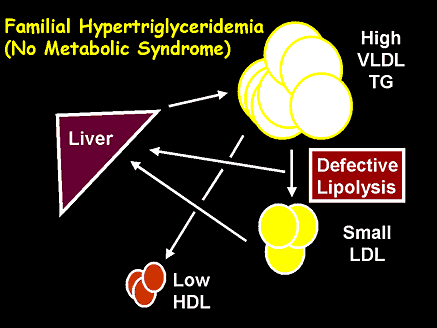Most people above a certain age are recommended to keep an eye on their blood pressure and cholesterol levels. There is something else, though, that you should take into consideration – your triglycerides. Triglycerides are a type of lipid or fat found in your blood. When you have something to eat, your body stores the excess calories not immediately used as fat; more specifically, triglycerides. Triglycerides are stored in your fat cells. Later, in between meals, your hormones release more triglycerides so that you might have some extra energy to do what needs to get done. If, for example, you eat more calories than you burn, such as simple sugars, carbohydrates and fat, your triglycerides may be considered high and this is also known as hypertriglyceridemia.

What Are the Symptoms of Hypertriglyceridemia?
More often than not, there are no symptoms of hypertriglyceridemia. Development of pancreatitis is such a symptom though. Pancreatitis is the inflammation of you pancreas and acute pancreatitis can be deadly, especially if not caught in time. However, a very simple blood test can tell you if the triglycerides are in the normal range or not.
Normal: Less than 150 milligrams per deciliter (mg/dL) or less than 1.7 millimoles per liter (mmol/L).
Borderline High: 150-199 mg/dL (1.8 to 2.2 mmol/L)
High: 200 to 499 mg/dL (2.3 to 5.6 mmol/L)
Very High: 500 mg/dL or more (5.7 mmol/L or more)
Hypertriglyceridemia more often than not occurs all on its own from a poor diet. However, it is usually a part of metabolic syndrome, a medical condition that can cause the risk for heart attack, diabetes, and stroke to increase. Other problems combined with metabolic syndrome include:
Low HDL ("good") cholesterol
High blood pressure
High blood sugar
Too much fat on body, especially around the waist
What Causes Hypertriglyceridemia?
For a good treatment of Hypertriglyceridemia, knowing the general causes can help in the long term.
Most common causes are obesity, poorly controlled diet and diabetes. If you are sedentary, your triglycerides may be high, especially if you consume a high amount of sugary foods and drinks, as well as a lot of carbohydrates and drink a lot of alcohol.
The binge drinking of alcohol can cause spikes that can lead to dangerous triglyceride levels and can trigger pancreatitis. There are other risks of high triglycerides such as hyperthyroidism, kidney disease, and certain inherited lipid disorders.
Medications can also cause high triglycerides to an unhealthy level. For example, Tamoxifen, steroids (such as prednisone), beta blockers, diuretics or water pills, birth control pills, etc.
Replacement estrogen therapy, most often used for menopause, can also cause this spike in triglycerides.
What Are the Treatments of Hypertriglyceridemia?
Lifestyle Changes
A healthy lifestyle is a key to treat and prevent high triglyceride.
The first thing you should do is to lose weight. You may think that you have to lose a ton of weight to lower your triglycerides, but simply losing 5 to 10 pounds can often do the trick. Not only will your triglyceride start returning to normal but you will also have a higher energy level and improved health.
Another way is to cut back on your calories. Although calories are energy, if you don't use the energy, you store it as fat. To lower triglyceride levels for the hypertriglyceridemia treatment, cut out the extra calories you do not need. For example, instead of a bad calorie treat, eat a vegetable such as carrot stick or celery sticks.
Avoid sugary or refined food stuffs. They are notorious for being bad on your health and containing immense amounts of calories.
Limit your cholesterol intake. Make sure that if you do not have heart disease, you take in no more than 300 mg of cholesterol. If you have heart disease, make this amount 200 mg. Again, as mentioned, foods that you eat play a huge roll. Fatty foods and sugary foods contain more cholesterol than their lower calorie/fat options.
Choosing healthier fats can also help. Eating foods with monounsaturated fats found in plant like olive, peanut and canola, instead of saturated fats, help with higher triglyceride levels. Instead of choosing red meat which is high in triglycerides, eat fish high in omega-3 fatty acids such as mackerel or salmon.
Try eliminating trans-fat as well which is often found in fried foods or commercially baked products such as crackers, cookies or snack cakes. Do not rely on the nutritional information to tell you whether or not a certain food has trans-fat. In the United States, if a certain food has 0.5 grams of trans-fat or less, the companies can simply put 0 on the package. Look through the ingredients for partially hydrogenated oil which is trans-fat and if you see it, don't buy and eat it.
Do exercises. A good way to start a healthier living is to exercise 30 minutes every day, 6 days out of 7 at least. This can raise your HDL ("good") cholesterol and lower LDL or ("bad") cholesterol and triglycerides. If you do not have much time because of a hectic schedule, fitting in 10 minutes by doing either sit-ups or push-ups in front of the television can help. Walking and taking the stairs at work are also good ways to go about exercising.
Medications
For hypertriglyceridemia treatment, if the lifestyle changes alone are not enough, different medications will be prescribed by your physician. The focus of medication therapy would be to raise the HDL and lower the LDL cholesterol. This is in advance of trying to lower your triglycerides. Such meds include Niacin, fibrates (such as Lofibra, TriCor, and Lopid), Omega-3 fatty acids such as fish oil, and finally statins.
Medications can be dangerous if taken with some other medications, so listen to your pharmacist and take all your medications exactly as asked for avoiding medication interacting.

View All Comments /Add Comment